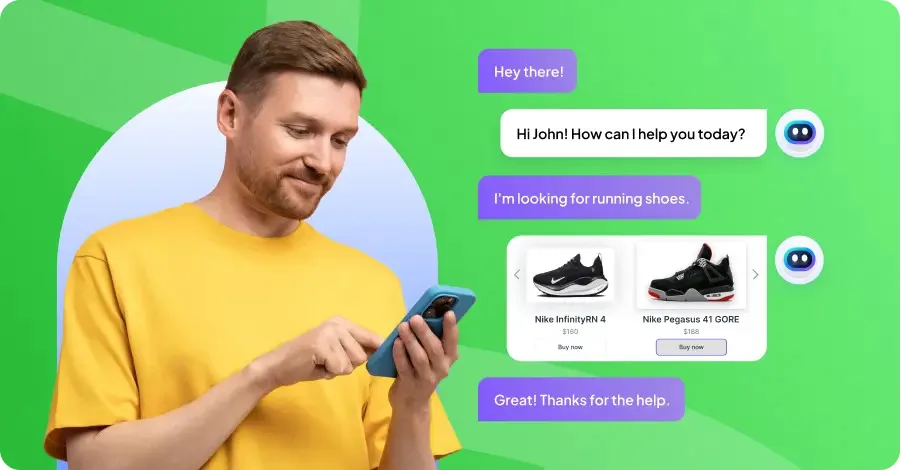40 Potential Use Cases for Chatbots in Banking
- June 12, 2024
- 13 mins read
- Listen

Table of Content
Banking chatbots are increasingly gaining prominence as they offer an array of benefits to both banks and customers alike. It has emerged as a transformative tool with its versatile use cases in banking. It optimizes banking tasks, enhances efficiency, boosts user satisfaction, and fosters digital advancement. These AI tools are available 24/7, so you don’t have to wait in line.
Big banks like Bank of America and Wells Fargo use chatbots. For example, Bank of America’s “Erica” helps with basic banking tasks. With natural language processing (NLP), chatbots can handle personalized requests and quickly solve problems.
Chatbots improve customer service and reduce costs for banks. They handle routine tasks and answer lots of questions. Remember, it frees up human input for more complex issues. They also collect and analyze data, helping banks offer better, customized services.
Moreover, banking chatbots improve security by using encryption to protect your data and make transactions safe. As customers expect faster and more personalized support, chatbots meet these needs effectively. Let’s move to the benefits of implementing chatbots in banking.
The Benefits of Implementing Chatbots in Banking
Chatbots in banking offer numerous benefits. PwC found that 73% of customers expect service available 24/7. Chatbots offer this capability, enabling users to check balances, transfer money, and resolve basic issues anytime and anywhere, as reported by Juniper Research. Here are some more benefits you may consider.
1. Instant, Round-The-Clock Customer Service
Do you have any queries from your bank? Any financial questions or need any help? Here, Chatbots are available 24/7 to help you out. You can ask any question or for any help day or night. They are always ready to help you.
Chatbots are especially important for global banks with customers in different time zones. Immediate assistance improves customer satisfaction. It also increases the bank’s reputation for reliability and accessibility.
2. Reduce the Need for Human Agents and Save Costs
Chatbots take care of a lot of common customer questions. It means you don’t need as many people on your customer service team. This can save you a lot of money.
They also let you use your resources for more important things. With limited staff needed and less money spent on training new hires, your overall productivity and efficiency get an improvement.
3. Ensure Operational Efficiency With Fast Resolutions
Chatbots provide instant answers to common questions. It reduces wait times and provides quick solutions. This is important during busy times or special promotions when customer service gets a lot of inquiries. By handling high volumes efficiently, chatbots help keep the service quality consistent.
4. Be a Pioneer of Digital Banking
Remember, using chatbot technology helps banks lead the way in digital banking. Chatbots easily connect with mobile apps and online banking websites. This makes it simple for customers to get help whenever they need it. This flexibility makes the user experience better and shows that the bank cares about using innovative solutions.
5. Extend Support in Multiple Languages
Chatbots in banking and financial services open the doors for customers with different language backgrounds. This multilingual capability ensures that customers can perform banking transactions, seek financial advice, and resolve issues in their preferred language. So, the customer are more satisfied with the banking system when it comes with a multilingual bot.
6. Maximize the Use of Customer Data and Insights
Gather important information from every conversation using a chatbot. By looking at this information, banks can spot trends, preferences, and issues, helping them make smart decisions.
Chatbots can also customize interactions based on a customer’s past behavior. Here, you will get personalized solutions and tips. This makes the customer experience better and helps prevent fraud by quickly warning customers of unusual transactions.
40 Potential Use Cases for Chatbots in Banking
Gone are the days of navigating complex banking menus and waiting for customer service representatives. Banking chatbots are here to empower you with a smarter way to manage your finances. Let’s explore the diverse use cases for chatbots in banking.
Account Management
- Check Balance: Bank customers can conveniently check their bank account balance through a chatbot, which only requires identity verification and information input.
- Account Opening: Chatbots help with opening bank accounts. Customers provide the necessary information. The bank collects this information. The information is sent to the bank’s management system. An account is automatically opened following the bank’s rules.
- Mini Statement: You can avail a summary of recent transactions in a bank account by following the same process mentioned above. It typically includes the latest few transactions, such as deposits, withdrawals, and balance inquiries. This condensed version of a full account statement is designed for quick reference, providing a snapshot of recent account activity.
- Account Statement: AI chatbot gives users a detailed account statement. It securely verifies their identity and retrieves transaction data from the bank’s systems. The information is formatted and delivered through the chat interface. This statement includes deposits, withdrawals, transfers, and other activities, providing a complete financial history.
- Check BVN (Bank Verification Number): Users can obtain their BVN or any personal verification information through chatbots. These unique identifiers are linked to bank accounts, enhancing security and authentication for transactions.
- Block Card (Debit/Credit Card): In case of loss, theft, or suspected fraud, chatbots enable users to block or suspend their debit or credit cards. It helps to prevent unauthorized transactions and secure their accounts.
- Account Maintenance (Account Tier Check, Account Types Check, Account Status): Chatbots offer users account maintenance services, such as checking account tier status, account types, and status updates, ensuring accurate and up-to-date account information.
- Freeze Account: Through chatbots, users can temporarily freeze their accounts to prevent unauthorized access and transactions, maintaining security until they choose to unfreeze the account.
- Spend Limit Check: Users can rely on chatbots to verify their spending limits and transaction thresholds. It ensures that they maintain responsible financial habits and do not exceed their limits.
- Manage Beneficiaries: Manage beneficiaries by adding, removing, or updating beneficiary information for fund transfers and bill payments.
- Request Checkbook: Chatbots make it easy for users to request checkbooks, guiding them through the process and confirming the submission of their request.
- Profile Update: Assist users in updating their profile information, such as contact details, addresses, and personal information.
Transactions
- Airtime Top-up: Airtime top-up is easy with a chatbot. Users can provide their mobile number, select the desired top-up amount, and let the chatbot do the rest.
- Buy Data: With chatbots, users can seamlessly buy mobile data bundles through the chat interface, ensuring quick transactions and immediate activation of data for uninterrupted connectivity.
- Bill Payment (Several use cases based on the type of payments): Chatbots support various bill payments, including utilities, credit card bills, and subscriptions, by providing a convenient platform for users to input payment details and complete transactions securely.
- Send Money (same bank account, another bank account): Simplify sending money securely and efficiently. Chatbot for banks allows users to transfer funds between their accounts or to accounts at different banks hassle-free. By guiding users through the essential steps and securely managing transactions within the messaging platform. They simplify the process and eliminate the necessity for separate banking apps or websites.
- Check Deposit: Through the chat interface, chatbots facilitate digital check deposits by capturing check images, verifying the details, and initiating the deposit process with the user’s bank.
- Loan Eligibility: Determine user eligibility for loans by collecting relevant financial information. Assess eligibility criteria based on predefined parameters. Chatbots provide users with personalized loan eligibility insights and guidance on the next steps.
Information Services
- Check Exchange Rate: Banking chatbots provide real-time exchange rate information for various currencies. It enables users to quickly check current rates and make informed currency exchange decisions.
- ATM/Branch Locator: You can get the chatbot’s assistance in finding nearby ATMs and branches by utilizing geolocation data or user-provided location information. It offers directions and additional details about each location for convenience.
- View Product & Services: The chatbot provides information about the bank’s products and services, including features, benefits, eligibility, and application procedures. This helps users explore their options and make informed decisions.
- Loan Facility Information: You can information on available loan facilities, including types of loans, eligibility requirements, interest rates, repayment terms, and application processes. They assist users in understanding loan options and accessing relevant resources.
Insurance Industry
- Policy Management: Chatbots enhance policy management by offering quick access to policy details, facilitating updates, and providing assistance for queries or claims processing. Utilizing conversational interfaces, users can effectively explore policy information, make modifications, and receive individualized support, improving overall convenience and accessibility.
- Claims Processing: With the banking chatbot, you can streamline the claims submission process by guiding users step-by-step, collecting necessary information, and providing timely updates on claim status.
- Insurance Quoting and Underwriting: Offer personalized insurance quotes based on user inputs, such as coverage requirements and demographics. It can assist in underwriting by collecting necessary data and assessing risk factors to determine premium rates.
- Risk Assessment and Mitigation: The banking bot assists with risk assessment and management by asking questions, analyzing scenarios, and providing educational content. It uses user input to offer personalized advice on reducing risks and following best practices.
- Fraud Detection and Investigation: Chatbots help detect and investigate fraud by chatting with users to confirm transaction details and spot suspicious activities. They use machine learning to study past data for signs of fraud. If needed, automated alerts are sent to the right people. Plus, the chatbot helps document incidents and shares tips with users on spotting and stopping fraud.
Customer Support
- Lodge/View Complaints: Enable users to lodge complaints efficiently by guiding them through the process with a banking chatbot. Collect necessary details and confirm complaint submission.
- Collect Feedback: By presenting targeted questions and response options, chatbots seek feedback from users about banking products or services.
Identity Management (KYC)
- Customer Onboarding: Customer onboarding with a banking chatbot involves guiding users through the account opening process seamlessly. The chatbot assists users in providing necessary personal information, selecting account options, and agreeing to terms and conditions. It ensures a smooth onboarding experience by offering assistance and answering any questions users may have.
- Identity Verification: After users create their accounts, the chatbot asks them to upload identification documents like government IDs or passports. Then, it checks if these documents are real by sending encoded data (which is a special way to represent files) for verification.
- Document Verification: Chatbots in financial services help users upload documents and ensure they are complete and accurate. It may also guide if any documents are missing or need to be corrected before submission.
- OTP Verification (SMS, Google Authenticator): For added security in the KYC process, the chatbot can link with APIs to verify OTPs. It sends one-time passwords (OTPs) to users via SMS for authentication. Alternatively, it integrates with apps like Google Authenticator to generate secure OTPs. Users then input these OTPs to confirm their identity and safely proceed with KYC.
Generic Use Cases (Bank & Other Industries)
- Response General FAQs: Chatbots swiftly and accurately respond to common questions, making customer service more efficient and users happier.
- Language Understanding (LLM & Gen AI): You can utilize advanced language understanding models, such as Large Language Models (LLM) and General AI, to comprehend user queries accurately and respond effectively in natural language.
- Transfer Chat to Specific Department: The banking chatbot can route user inquiries to the appropriate department or agent based on the nature of the query, ensuring efficient handling and resolution of user issues.
- Take User to Specific Flow when Chatbot cannot Answer: When chatbots are unable to answer user queries, they can guide users to specific workflows or escalation paths for further assistance. It minimizes user frustration and ensures issue resolution.
- Understand User Sentiment: Chatbots in banking can analyze user sentiment based on their interactions and responses. It allows businesses to gauge customer satisfaction levels and identify areas for improvement in products or services.
- Gen AI-Based Auto Learn and Response: A big advantage of banking chatbots is how they keep learning. With Gen AI, chatbots learn from users, change to fit their needs and get better at giving answers as time goes on, all without needing specific programming.
- Send Data to CRM: Chatbot has integration capabilities with CRM systems. It captures and stores user interactions and data, enabling businesses to track customer engagement and personalize future interactions effectively.
Frequently Asked Questions
What is a use case in banking system?
A use case in a banking system specifies the interaction between a user and the bank’s operational structure. It specifies the series of steps required for a given task. For instance, opening bank account, checking bank balance, transferring funds etc.
What is a chatbot in banking?
A chatbot in banking acts as an AI-driven assistant employing technologies like generative AI and LLM to aid interactions between banks and customers at certain moments.
Are chatbots secure for banking?
Security is a significant consideration when implementing technology in confidential systems. In the context of banking chatbots, it is essential to be cautious about the information you disclose—be clear on what is appropriate to share and what should remain private.
Is human support in banks still essential alongside the use of a chatbot?
Yes, banks need both chatbots and humans. Chatbots are good for quick answers and simple tasks. Humans are needed for complex problems, personalized advice, and understanding customers’ unique feelings.
What happens if the chatbot can’t answer my question?
With advanced customer engagement platforms like REVE Chat, there’s a feature for human-bot collaboration. If the chatbot fails to respond to a query, you have the option to switch to human agent assistance.
Final Note
Looking forward, banking chatbots are likely to become better as technology like artificial intelligence and natural language processing keeps advancing. Every time you chat with them, they get to know you better, making your banking experience more personalized. That is what we are looking into. A future full of convenience in the banking systems.





